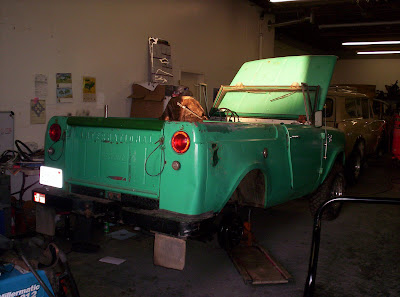
Monday, May 5, 2008
Thursday, April 24, 2008
1963 Scout + Toyota 2LT
The guys at the shop are putting everything back together. Since I haven't actually driven it yet, all I can do is list off the new goodies and wait patiently. Planning a road trip next month, subjectivity forthcoming.
Toyota 2LT turbo diesel with 5-speed gearbox and transfer case (mechanical fuel pump); rebuilt Dana 44 rear, 4.27 gears and new drive shafts; new front disc brakes; new radiator, intercooler, and EGT gauge; new wiring harness; new shocks and springs; rebuilt Scout II bucket seats and roll bar (for 3pt seat belts!).
Rest assured this is still an International, despite the Australian-printed engine manual for the Toyota Hi-Lux and 4Runner diesels. It wouldn't be fun if there weren't projects left for me: having two (refinished) fuel tanks makes for straight-forward WVO conversion, and it's just crying for custom-welded bumpers. Stay tuned.
I'm selling the old 1963 Comanche 152 cu. in. engine.
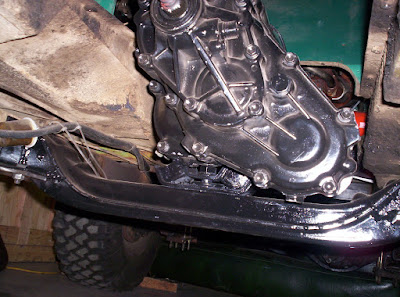
Toyota 2LT turbo diesel with 5-speed gearbox and transfer case (mechanical fuel pump); rebuilt Dana 44 rear, 4.27 gears and new drive shafts; new front disc brakes; new radiator, intercooler, and EGT gauge; new wiring harness; new shocks and springs; rebuilt Scout II bucket seats and roll bar (for 3pt seat belts!).
Rest assured this is still an International, despite the Australian-printed engine manual for the Toyota Hi-Lux and 4Runner diesels. It wouldn't be fun if there weren't projects left for me: having two (refinished) fuel tanks makes for straight-forward WVO conversion, and it's just crying for custom-welded bumpers. Stay tuned.
I'm selling the old 1963 Comanche 152 cu. in. engine.

Wednesday, November 28, 2007
Re: Turbo Diesel
The green '63 has been in the shop getting a new engine, formerly belonging to a 1990s Toyota Land Cruiser diesel of Canadian origin. (We won't worry about vehicle inspections or smog certificates, since it predates emissions regulations.) The two liter turbo diesel has been mounted.
This is the engine, transmission, and transfer-case assembly:
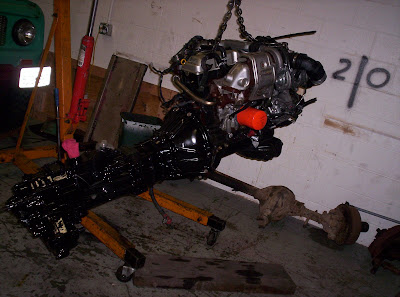
The view from above:
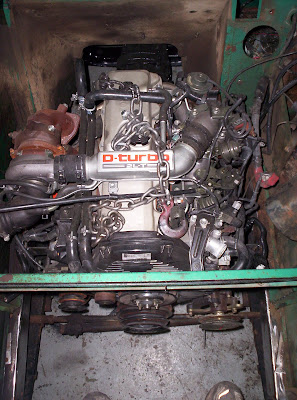
This engine is a little taller than the old one, so it needed to be raised a few inches for the oil pan to clear the axle:
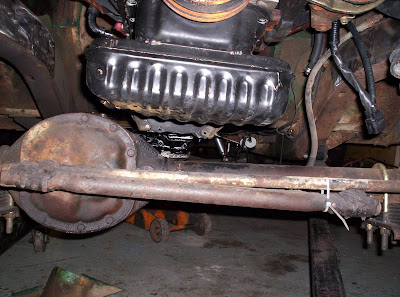
This meant the bench seat has to go, to make room for the shifter. I didn't like the bench seat anyway.
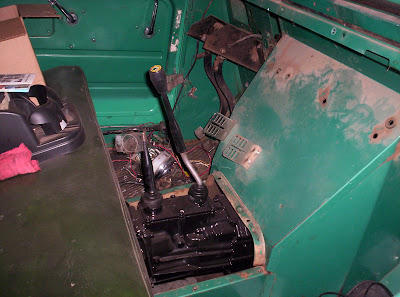
This is the engine, transmission, and transfer-case assembly:

The view from above:

This engine is a little taller than the old one, so it needed to be raised a few inches for the oil pan to clear the axle:

This meant the bench seat has to go, to make room for the shifter. I didn't like the bench seat anyway.

Tuesday, July 17, 2007
Not no tiny little car gears
My uncle from LA said something along the lines of, "having a four wheel is added insurance for you, people who drive 4x4s are the kind of people who have guns."
I've got a 4x4 parked outside but the Dana 20 transfer case (the component which allows you to select between 2WD and 4WD low/high) doesn't work. Would-be perpetrators will want to watch out for me, even if I'm stuck in two-wheel drive. Keith from the scout shop said he even tried pushing on the lever with his legs.
That's the thing about the the scout, it's more like driving a tank than a passenger car. You can push levers as hard as you want. This is a three-speed/reverse unsynchronized manual transmission:
This means downshifting is difficult, but it doesn't bother me because when these gears grind it sounds like, "sorry, you have made an incorrect selection. please select a different gear." There are metal-on-metal sounds but it's BIG TOUGH metal gears refusing to mesh with BIG TOUGH metal gears at high RPM.
I know what you'll say, I should get a tractor.
I've got a 4x4 parked outside but the Dana 20 transfer case (the component which allows you to select between 2WD and 4WD low/high) doesn't work. Would-be perpetrators will want to watch out for me, even if I'm stuck in two-wheel drive. Keith from the scout shop said he even tried pushing on the lever with his legs.
That's the thing about the the scout, it's more like driving a tank than a passenger car. You can push levers as hard as you want. This is a three-speed/reverse unsynchronized manual transmission:
- The earliest automotive transmissions were entirely mechanical unsynchronized gearing systems. They could be shifted, with multiple gear ratios available to the operator, and even had reverse. However, the gears were engaged by sliding mechanisms or simple clutches, which required careful timing and throttle manipulation when shifting, so that the gears would be spinning at roughly the same speed when engaged; otherwise, the teeth would refuse to mesh.
When upshifting, the speed of the gear driven by the engine had to drop to match the speed of the next gear; as this happened naturally when the clutch was depressed or disengaged, it was just a matter of skill and experience to hear and feel when the gears managed to mesh. However, when downshifting, the gear driven by the engine had to be sped up to mesh with the output gear, requiring letting the clutch up (engagement) for the engine to speed up the gears. Double declutching, that is, shifting once to neutral to speed up the gears and again to the lower gear, is sometimes needed. In fact, such transmissions are often easier to shift without using the clutch at all. When using this method, the driver has to time the shift with relative precision to avoid grinding the gears. The clutch, in these cases, is only used for starting from a standstill. This procedure is common in racing vehicles and most production motorcycles.
Even though automotive transmissions are now almost universally synchronised, heavy trucks and machinery as well as dedicated racing transmissions are usually non-synchromesh transmissions, known colloquially as "crashboxes", for several reasons. The friction material, such as brass, in synchronizers is more prone to wear and breakage than gears, which are forged steel, and the simplicity of the mechanism improves reliability and reduces cost. In addition, the process of shifting a synchromesh transmission is slower than that of shifting a non-synchromesh transmission. For racing of production-based transmissions, sometimes half the teeth (or "dogs") on the synchros are removed to speed the shifting process, at the expense of greater wear.
This means downshifting is difficult, but it doesn't bother me because when these gears grind it sounds like, "sorry, you have made an incorrect selection. please select a different gear." There are metal-on-metal sounds but it's BIG TOUGH metal gears refusing to mesh with BIG TOUGH metal gears at high RPM.
I know what you'll say, I should get a tractor.
Friday, July 6, 2007
Re: Rear Axle
Brian at the scout shop sent me pictures of the rear axle (a Dana 27), showing where the old U-bolts had dug deep grooves in the metal.
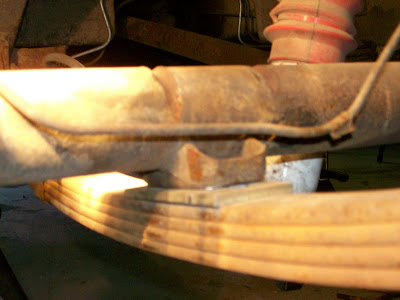

Sunday, July 1, 2007
Re: Fuel system
I had the scout in a rental garage until the owner called to complain, "it's stinking up the entire house (it's really cool, I remember [in my day] ..., great color!)". In part this is due to 40 years of dirt and debris (and it helps that there's no catalytic converter), but mainly it's the smell of gasoline, which spills from a hole somewhere near the top of the left-side tank.
There's a switch on the dash to select between left and right tanks, but the fuel-gauge only displays the right side, and the sender (which sends the level to the gauge) is broken.
Step 1: repair/replace left-side tank, replace fuel filters (3), replace senders (2), new marine tank filler caps (2), and dual-sender circuit.
There's a switch on the dash to select between left and right tanks, but the fuel-gauge only displays the right side, and the sender (which sends the level to the gauge) is broken.
Step 1: repair/replace left-side tank, replace fuel filters (3), replace senders (2), new marine tank filler caps (2), and dual-sender circuit.
1963 Int'l Scout 80
- 1963 International Harvester : Scout
1963 International Scout, 80, 4cyl all wheel drive
1963 International Scout 80. All wheel drive, removable hardtop, runs and drives great! new tires, fuel lines, electric switch between fuel tanks, clutch master cyl and slave cyl rebuilt, extra set of wheels and tires.
Used a couple of times a week as a spare veh. For a 63 she is in great shape, minor surface rust only, needs a paint job
put in the key pull out the choke and start her up. Take her top off and head down to the beach, or up to the mountains, she is at home in either place.
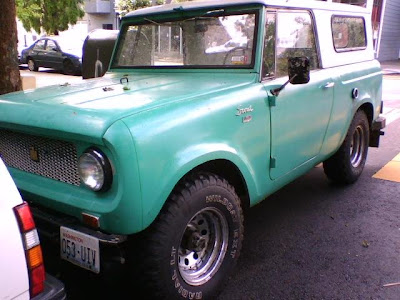
I won the bidding for $2,500 plus $650 for shipping from Rochester, WA.
This is a truck that drives like a tank (with roll-down windows and AM radio). 31 inch tires and bad-ass green paint. 85 horsepower gasoline engine and 3-speed manual transmission. People give me looks. The horn is awesome (best was Pete's description, "titty honking" along with two-handed squeeze gesture).
Top speed (freeway): 60mph
Top speed (hills): 5mph
I've driven about 150 miles, half of them with an ear-to-ear grin. It's a perfect beach cruiser, but it needs more power (and maybe an automatic transmission, satellite radio). I'm looking for a small, efficient turbo-diesel engine and a little restoration.
I made a few phone calls and found a new Scout shop in Redwood City, CA. Their chief mechanic named Keith somehow reminds me of Beavis (of Beavis and Butthead). His t-shirt reads "I'm the mechanic your mother warned you about" and he knows all there is to know about the IHC Scout.
It's in the shop now getting a 2.5" lift (new springs, bushings, and shackles) and Rancho 9000 RSX adjustable shocks.
(Anything else is just a car: this is not the first blog about a 1963 scout.)
Subscribe to:
Comments (Atom)